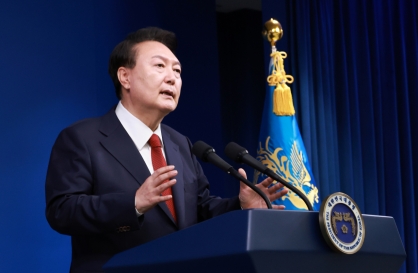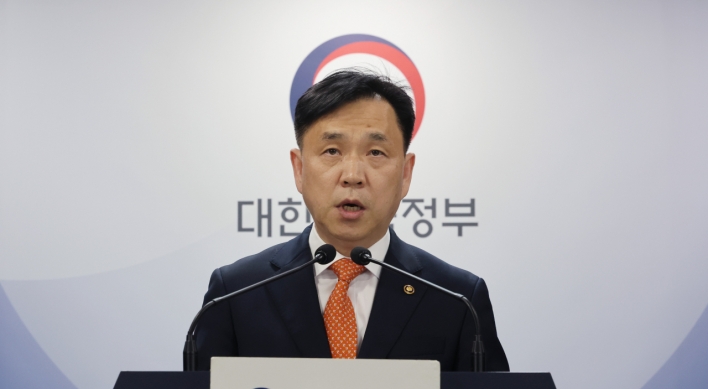[Editorial] Steady job growth
Efforts required to tackle youth unemployment
By Korea HeraldPublished : Jan. 16, 2014 - 20:04
The employment data for 2013 released by Statistics Korea is cause for both concern and optimism.
The figures raise concern as the employment rate of young people between 15 and 29 has fallen below the 40 percent mark for the first time since 2000, when the statistics agency began to compile the relevant data.
Last year, the youth employment rate fell to 39.7 percent from 40.4 percent in 2012. The drop contrasted with the improvement in the employment situation for other age groups. The youth employment figure peaked at 45.1 percent in 2002 and 2004 before sliding gradually.
The youth unemployment rate also jumped to 8 percent from 7.5 percent a year ago, while the jobless rate for all age groups edged down to 3.1 percent from 3.2 percent the previous year.
The problem is that labor market conditions for young people are not likely to improve much this year, even though the economic recovery is expected to pick up pace.
A recent employment survey says the nation’s top 30 business groups are likely to create slightly fewer jobs for college graduates than last year’s 128,000. It found that groups planning to scale back their hiring schemes outnumbered those planning to scale up.
One reason for top business groups’ reluctance to expand employment is the still-murky outlook for the Korean economy. They are also held back by the expected 10-15 percent wage increase due to the Supreme Court’s recent ruling on the scope of ordinary wages.
But the jobs data also gives us some cause for optimism. In December, the economy added 560,000 jobs, the second straight month when job creation topped 500,000. In November, job creation was even stronger with 588,000 new jobs added. The number of employed young people aged between 15 and 29 also increased by 53,000, the fourth straight monthly gain.
The pace of job growth quickened from 257,000 in the first quarter to 324,000 in the second, 421,000 in the third and 541,000 in the final quarter, another sign that the labor market is gradually improving.
The job growth was led by the health care and welfare services sectors. Statistics Korea suggests the government policies introduced last year to help women get back to work have started to work. It notes that the economically active female population continues to increase as more women freed from child care and household duties seek to find jobs.
The government’s efforts to create high-quality part-time jobs for women and senior citizens will help boost the employment rate. But it needs to redouble efforts to improve the dire situation facing young job seekers.
To boost youth employment, the government needs to build a comprehensive work-to-school system to help high school graduates get a job before pursuing a college education.
This system will not only address the youth unemployment problem but provide relief to households struggling with the excessive financial burden of paying for their children’s education. This will in turn increase household spending and stimulate domestic consumption.
The figures raise concern as the employment rate of young people between 15 and 29 has fallen below the 40 percent mark for the first time since 2000, when the statistics agency began to compile the relevant data.
Last year, the youth employment rate fell to 39.7 percent from 40.4 percent in 2012. The drop contrasted with the improvement in the employment situation for other age groups. The youth employment figure peaked at 45.1 percent in 2002 and 2004 before sliding gradually.
The youth unemployment rate also jumped to 8 percent from 7.5 percent a year ago, while the jobless rate for all age groups edged down to 3.1 percent from 3.2 percent the previous year.
The problem is that labor market conditions for young people are not likely to improve much this year, even though the economic recovery is expected to pick up pace.
A recent employment survey says the nation’s top 30 business groups are likely to create slightly fewer jobs for college graduates than last year’s 128,000. It found that groups planning to scale back their hiring schemes outnumbered those planning to scale up.
One reason for top business groups’ reluctance to expand employment is the still-murky outlook for the Korean economy. They are also held back by the expected 10-15 percent wage increase due to the Supreme Court’s recent ruling on the scope of ordinary wages.
But the jobs data also gives us some cause for optimism. In December, the economy added 560,000 jobs, the second straight month when job creation topped 500,000. In November, job creation was even stronger with 588,000 new jobs added. The number of employed young people aged between 15 and 29 also increased by 53,000, the fourth straight monthly gain.
The pace of job growth quickened from 257,000 in the first quarter to 324,000 in the second, 421,000 in the third and 541,000 in the final quarter, another sign that the labor market is gradually improving.
The job growth was led by the health care and welfare services sectors. Statistics Korea suggests the government policies introduced last year to help women get back to work have started to work. It notes that the economically active female population continues to increase as more women freed from child care and household duties seek to find jobs.
The government’s efforts to create high-quality part-time jobs for women and senior citizens will help boost the employment rate. But it needs to redouble efforts to improve the dire situation facing young job seekers.
To boost youth employment, the government needs to build a comprehensive work-to-school system to help high school graduates get a job before pursuing a college education.
This system will not only address the youth unemployment problem but provide relief to households struggling with the excessive financial burden of paying for their children’s education. This will in turn increase household spending and stimulate domestic consumption.
-
Articles by Korea Herald





![[K-pop’s dilemma] Can K-pop break free from ‘fandom’ model?](http://res.heraldm.com/phpwas/restmb_idxmake.php?idx=644&simg=/content/image/2024/05/09/20240509050541_0.jpg&u=20240509173751)




![[News Analysis] Yoon's first 2 years marked by intense confrontations, lack of leadership](http://res.heraldm.com/phpwas/restmb_idxmake.php?idx=644&simg=/content/image/2024/05/09/20240509050612_0.jpg&u=20240509233252)








![[Today’s K-pop] NCT’s Mark to drop 1st solo album in February 2025](http://res.heraldm.com/phpwas/restmb_idxmake.php?idx=642&simg=/content/image/2024/05/10/20240510050597_0.jpg&u=)